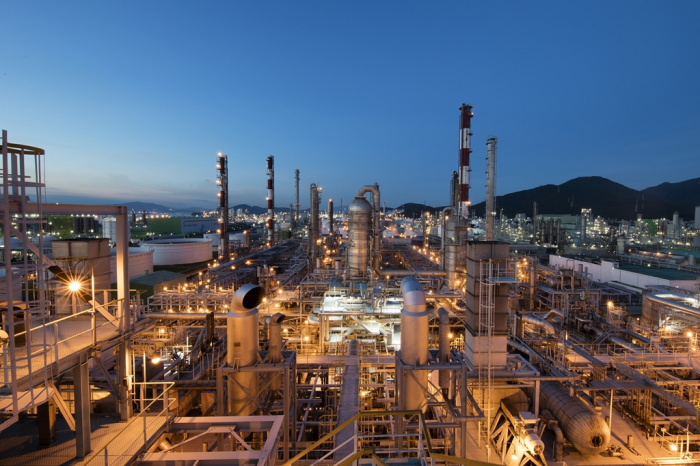
Lotte Chemical’s complex in Yeosu, South Korea. The country’s petrochemical sector was seen hit the hardest by the rising global commodity prices and supply chain disruption, as well as a weaker won. South Korea’s major industries, especially the petrochemical and auto parts sectors, are suffering from surging global commodity prices, a weaker won and the worldwide supply chain crisis. Domestic consumption-oriented industries such as information technology businesses are also in pain as Asia’s fourth-largest economy faces risks of stagflation – rising inflation with an economic downturn.The total operating profit of the country’s 182 listed companies for 2022 was forecast at 204.5 trillion won ($158 billion), according to financial data provider FnGuide Inc. That was 6.7% higher than a consensus forecast of 191.7 trillion won predicted in early January before Russia invaded Ukraine.But 162 listed firms among them, excluding the semiconductor, shipping, airlines and energy industries that are enjoying a super cycle, are expected to report lower profits. Their combined operating profit was forecast to be 95.8 trillion won, 8.9% lower than the consensus made in early January.“The decline in profit forecast would be larger if companies without a consensus are included,” said an investment banking industry source.Such a dismal outlook reduced corporate investment. Capital expenditure fell 3.9% in the first quarter from the previous three months, the largest drop in three years, according to the Bank of Korea. The central bank expected capex this year to fall 1.5% in its economic forecast published last month, reversing its earlier prediction of 2.4% growth made in November 2021.The won on Wednesday weakened to 1,293.2 per dollar, the softest since March 19 2020, when the COVID-19 pandemic broke out globally. The South Korean currency is the worst performer among emerging Asian units with a 7.9% loss versus the greenback so far this year.A weaker won bit into South Korean corporate earnings as it raised costs of raw materials imports, rather than boosting price competitiveness in overseas markets.PETROCHEMICALSPetrochemical producers were seen as the hardest hit among local industries as soaring oil prices ramped up feedstock costs with their operating profit forecast down by 3.7 trillion won in total compared to a consensus in January, according to FnGuide.Korea Petrochemical Ind. Co., an ethylene producer with a naphtha cracker, was expected to log 50.9 billion won in operating profit this year, 80.3% lower than an earlier forecast of 257.8 billion won. Its larger competitor Lotte Chemical Corp. was predicted to report an operating profit of 560 billion won, less than a third of an earlier consensus of 1.7 trillion won.Shipbuilders and auto parts makers were seen as the main victims with their profit forecasts down by 1.2 trillion won each. Component manufacturers are hit by low production of carmakers due to the ongoing automotive chip shortage, while the combined profit of their customers including Hyundai Motor Co. and Kia Corp. was predicted at 813.1 billion won thanks to strong demand.A weaker won is unlikely to improve exporters’ profitability. A softer currency often helps enhance exporters’ price competitiveness in overseas markets, but the recent plunge in its value further boosted the costs of imports of raw materials which are already expensive. In addition, many exporters already operate production bases in other countries. Traders work at Hana Bank headquarters' dealing room in Myeong-dong, Seoul, on June 13. The won currency on June 15 extends losses to 1,293.2 per dollar, the softest since March 19 2020. TO HURT BOOMING INDUSTRIESOn the other hand, the semiconductor, transportation such as shipping and airline sectors, as well as refinery industries were expected to enjoy healthy earnings. Profits of Samsung Electronics Co. and SK Hynix Inc., the world’s two largest memory chipmakers, were expected to rise by 7.9 trillion won and 3.9 trillion won from earlier forecasts, respectively.HMM Co., South Korea’s top container line, was predicted to log a profit of 10.8 trillion won, far higher than an earlier forecast of 7.4 trillion won.Those industries were not free from the rising commodity prices and global supply disruption that could create a vicious cycle of intensifying inflation and hurting purchasing power, as well as demand eventually. Samsung and SK Hynix may be hit by a potential slowdown in demand for mobile gadgets and servers in the second half, for example.DECLINING CAPEXCompanies are expected to slash capex plans which had been planned, industry sources said.A local textile and chemical maker, which reported a record profit of some 300 billion won in 2021, revised its business plans for this year twice, lowering an operating profit target to 50 billion won last month from an initial 180 billion won.“We are considering cutting initially-planned capex plans due to intensifying cost pressures,” said a company official.Major conglomerates such as Samsung, Hyundai, SK and LG plan to set up contingency plans later this month.“The business environment is all foggy although truckers ended a strike with a dramatic agreement after negotiations,” said a source from one of those chaebol, or family-run conglomerates. “Risks are growing as the US and Chinese economies, key export markets, are shaking.”By Kyung-Min Kang and Eui-Myung Parkkkm1026@hankyung.comJongwoo Cheon edited this article.
Most Read